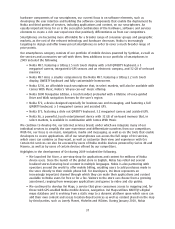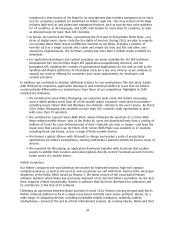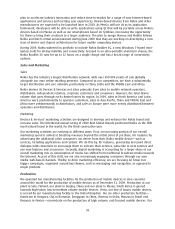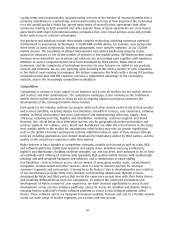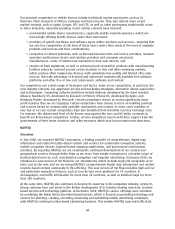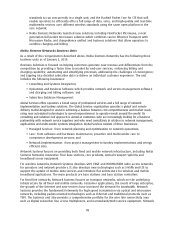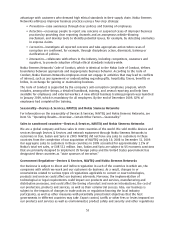Nokia 2009 Annual Report Download - page 48
Download and view the complete annual report
Please find page 48 of the 2009 Nokia annual report below. You can navigate through the pages in the report by either clicking on the pages listed below, or by using the keyword search tool below to find specific information within the annual report.for management analysis and decision making. Examples of these applications include
infrastructure cataloging and tracking for government agencies and utility companies, asset
tracking and fleet management for commercial logistics companies and demographic analysis.
In addition, NAVTEQ has a traffic and logistics data collection network in which it processes traffic
incident and event information, along with comprehensive traffic flow data collected through its
network of roadside sensors, in order to provide detailed traffic information to radio and television
stations, invehicle and mobile navigation systems, Internet sites and mobile device users. In 2009,
NAVTEQ also began receiving GPS data records from Nokia devices for use in NAVTEQ’s traffic data
products.
NAVTEQ’s map database is a highly accurate and detailed digital representation of road transportation
networks in Europe, North America and other regions around the world. This database offers
extensive geographic coverage, including data at various levels of detail for 78 countries on six
continents, covering more than 17 million miles of roadway worldwide. Unlike basic road maps,
NAVTEQ’s map database currently can have over 200 unique attributes for a particular road segment.
The most detailed coverage includes extensive road, route and related travel information, including
attributes collected by road segment that are essential for routing and navigation, such as road
classifications, details regarding ramps, road barriers, sign information, street names and addresses
and traffic rules and regulations. In addition, the database currently includes over 44 million points of
interest, such as airports, hotels, restaurants, retailers, civic offices and cultural sites. In 2009, NAVTEQ
continued to add new content to its database including junction views and city models. We believe
NAVTEQ’s digital map has the most extensive navigable geographic coverage of any commercially
available today.
Sales and Marketing
Sales
NAVTEQ provides its data to endusers through multiple distribution methods including retail
establishments, the Internet, automobile, handset and mobile device manufacturers and their dealers,
and other redistributors. NAVTEQ also offers distribution services to its customers, including the
manufacturing and shipping of digital storage media to automobile manufacturers and dealers or
directly to endusers, as well as a complete range of services, including inventory management, order
processing, online credit card processing, multicurrency processing, localized VAT handling and
consumer call center support.
NAVTEQ licenses and distributes its database in several ways, including licensing and delivering the
database directly and indirectly to its business customers and consumer endusers. In addition to the
basic license terms that typically provide for nonexclusive licenses, the license agreements generally
include additional terms and conditions relating to the specific use of the data.
The license fees for NAVTEQ’s data vary depending on several factors, including the content of the
data to be used by the product or service, the use for which the data has been licensed, the
geographical scope of the data and whether there is any advertising inventory associated with such
data. The fees paid for the licenses are usually on a percopy, per transaction or per subscription
basis. NAVTEQ also produces and delivers database copies to automobile manufacturers pursuant to
purchase orders or other agreements.
Marketing
NAVTEQ’s marketing efforts include a direct sales force, attendance and exhibition at trade shows and
conferences, advertisements in relevant industry periodicals, direct sales mailings and advertisements,
electronic mailings, Internetbased marketing and comarketing with customers.
46



